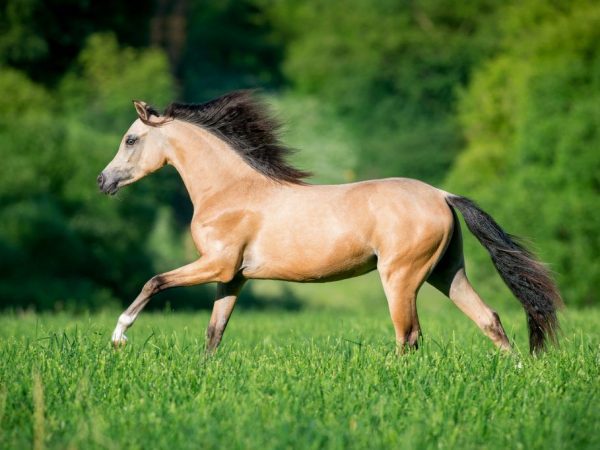The dun horse is the most valuable horse of the past
The eyes of not only scientists, but also ordinary people are riveted to animals with an unusual color. The Buck Horse is no exception, because it is the most valuable of the horses of the past, which has not lost interest on the part of breeders to this day. Why is this species shrouded in a mass of secrets and legends? What is her superiority over the rest of the equids? Let's figure it out.

Buck horse suit
Legends regarding the name of the suit
Even the most experienced zoologist-archivist cannot tell the exact time of the appearance of the dun horses. If you go on a trip in the past, you will notice that in the capital of Parthia, almost all stallions had a predominantly yellow body tint. However, if you look at the period of the XV-XVIII centuries, you can safely state the variety of horses used by society (dun, salted, etc.).
During the Baroque era, along with black horses, dun horses became popular among noble people (such a conclusion can be made from a photo of paintings that have survived to this day). Closer to our time, horses with a dark color were used more often, since they were considered more hardy and unpretentious compared to light yellow ones.
Currently, the world is presented with three options for the origin of the name of the brown horse suit:
- Consonance with the word "damask", associated with the armor of a victorious warrior, made of real steel and reflecting even the dimmest rays of sunlight.
- From the Tatar word "bulan", interpreted as "deer". Due to such an unusual color of the representative of the dun suit, similar to the horned master of the northern outskirts of the vast country, the Americans call him "the keeper of the deer skin."
- From the Türkic word "bolan" meaning "to darken". This interpretation is more related to the dark sweep of horses, however, it also has a place to be.
Despite such scattered legends about the origin of the name of dun horses, people's interest in them does not disappear, because it will be quite problematic to recreate such a rare and unique creature again.
The appearance of the dun suit of horses
The dunned stallion has a golden, yellow-sand color of the body and body and contrasting, black, - mane and tail (the photo can be easily found on the Internet). This combination of colors vividly emphasizes the stateliness, slenderness and attractiveness of the horses in question. Such a conclusion was made not only on the basis of the color of the hairs of the equid-hoofed, but also on the characteristics of its breed range (lungs, riding):
- Akhal-Teke;
- Karabakh;
- Donskoy;
- Budenovskaya, etc.
Distinctive features of the suit
What is the color of horses? This is a combination of the following animal characteristics: body hair color, mane, tail, skin and eyes. In other words, it is a set of certain genes responsible for the manifestation of one or another external element.
The brown color of a horse is not a separate suit, but a variety of black, characterized by:
- even color of the head and body (golden, white-yellow, light sand, cognac);
- black color of the hairs of the legs to the hock (on the hind) and carpal (on the front pairs) joints;
- gray skin;
- eye color from amber to hazel.
The presence of a wild gene in the genotype of the breed is indicated by the presence of a dark belt on the back and zebra-like limbs of horses (the leg is covered with stripes up to the hock or wrist joint). Faced with such a representative in a natural habitat or in a photo, we can safely say that this is not a dun horse, but a savrass.
Revenge of dun horses
The term "sweep" refers to the different shades of the suit. Bucky horses are:
- Dark. Body color from light brown to almost black (no reddish tints). There are dark marks and "apples" on the body.
- Golden. Intense body color with a golden sheen.
- In apples. The presence on the body of cells of a dark color, reminiscent of "bulk apples". The color of the body itself is sandy.
- Silver-brown. The hair color of horses is sandy, yellowish with a silvery sheen. A foal of this kind at birth is no different from the standard ones, and after molting, the fur begins to cast.
- Light brown. The body with the head has a shade that matches the color of the white sea sand and resembles the isabella color of horses. Distinctive features between them are the color of the iris and the pigmentation of the skin. Brown - amber eyes and gray pigmentation, isabella - blue gases and pink skin (association with "fake albinos").
It is no secret that representatives of different peoples still confuse the isabella and buckskin suits. Studies carried out by Russian scientists at the turn of the 20th century have confirmed that these two breeds are genetically related to black crows (“cremello” gene).
Whatever color the horse has, first of all it is an animal that requires some care and attention. If this is enough, then the dun color blooms like an apple tree (more and more "apples" - fruits appear on the body).


